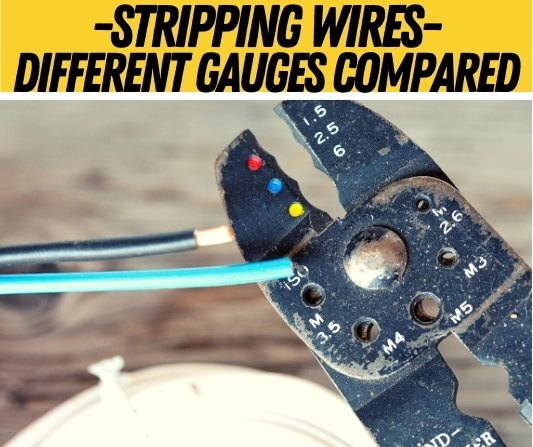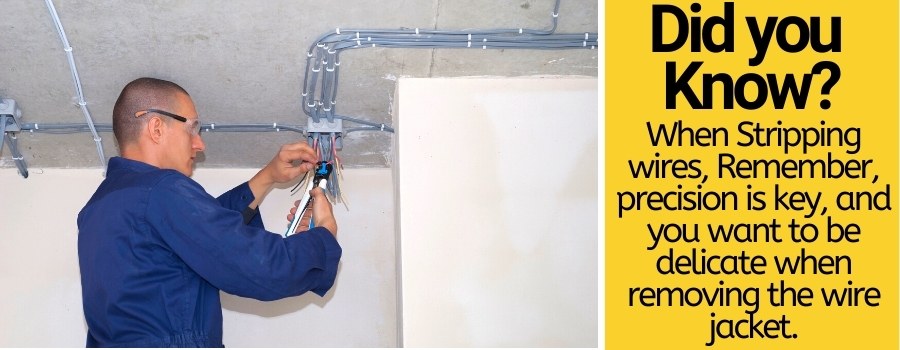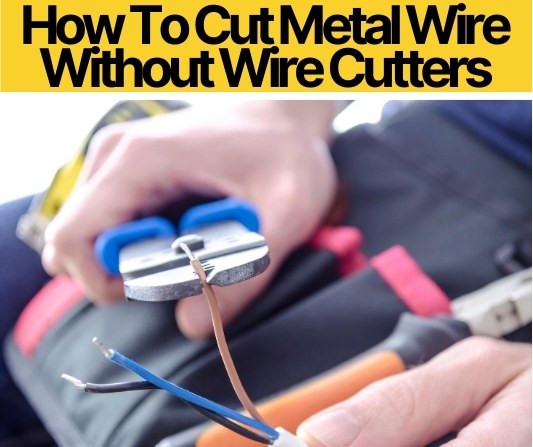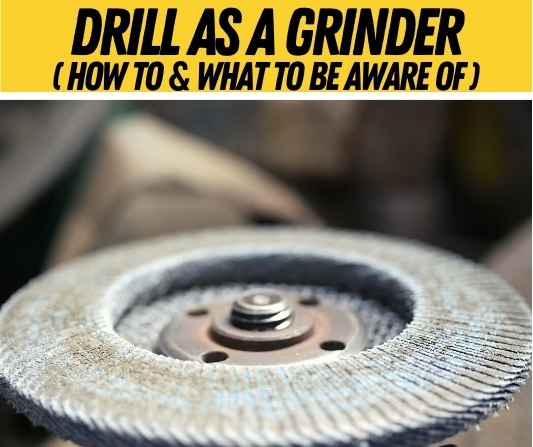 You may find yourself in a situation in which you need to strip some wire, and want to possibly use a tool you have at hand to do the job, without having to go out and buy a tool specifically for wire stripping.
You may find yourself in a situation in which you need to strip some wire, and want to possibly use a tool you have at hand to do the job, without having to go out and buy a tool specifically for wire stripping.
But different gauges of wires are not stripped the same,
and using a tool you use to strip a thick wire, could potentially ruin a thin wire.
How to Strip Different Gauge Wires
When stripping wire, there are two possible layers you will need to strip, the cable jacket and the insulation. These can come off as one, but if there are one than one wires inside the cable jacket, then they will need to be done individually. There are several tools you can use.
Wire strippers come in either manual or self-adjusting. The side of the manual wire stripper’s blade is serrated, with the dips between each serration suiting to a different gauge of wire. A self-adjusting wire stripper has the wire fed through two pairs of blades, with one pulling away from the other when activated, which pulls the jacket of the wire with it.
Simpler methods involve soldering irons and utility knives, but each method has its pros and cons, and are suitable for different gauges of wire which we will compare in this article.
General Tips & Tools needed to strip Really thin Wire
Often, wire strippers will have gauges too heavy for really thin wire, which is why it is often best to use a utility knife. Remember, precision is key, and you want to be delicate when removing the wire jacket. The best method can be to go around the wire jacket with the utility knife, gently enough not to nick the copper inside, but with enough pressure to pierce the jacket. Then, the end of the cable jacket can either be pulled off, or encouraged to part, by pushing it with the utility knife.
General Tips & Tools needed to strip Heavy Gauge Thick Wire
Heavy gauge wire is best stripped via the use of wire strippers, and if it is thick enough, then a Dremel could be used with a cutting wheel utility on the end. The Dremel has to be used very carefully, and the thickness of the wire jacket should be measured accurately to ensure the saw does not pierce the wire itself. It is a good idea to cut a significant amount of the cable jacket with the Dremel, and then use either brute force or a utility knife to do the rest. There may be smaller wires with insulation inside the cable jacket, so be careful when cutting through these.

Comparison Between Various Sizes
Knowing how to strip different gauges of wire is very important, as there is different methods used for each gauge, and one may not work for another. You can use a wire gauge tool to measure the diameter of your wire, or you can refer to an online chart that you can consult to measure your wire.
1/0 gauge wire
1/0 gauge wires are often used in vehicles, such as cars and boats, and you may have used them yourself, as they are the type of wire used to jumpstart a car. They can handle 300 amps, and can be made to be very strong and insulated.
In 1/0 gauge wires there is usually lots of different strands of copper, so you’ll want to remove the outer casing with a utility knife, or Dremel, to expose the copper, and be careful you do not accidentally sever any of the strands. If you nick any of the strands, it is best to cut off the end of the wire and start again.
2 gauge wire
2 gauge wire is another wire you will be familiar with as it is most commonly used for wiring in the house, and for appliances that use solar power. They can are good for 115 amps, and is also made up of several strands. Stranded wires are good for use in electronics, as they are very flexible, but are more susceptible to corrosion.
Like with the 1/0 gauge wire, you need to be careful when removing the cable jacket, as you could pierce one of the copper strands inside. It is inadvisable to use a Dremel at this point, a utility knife is a safer bet. Wire strippers can be made for wire gauge of 2, so they could also be used to remove the jacket.
4 gauge wire
4 gauge wire is usually stranded, and so once again you’ll need to be careful you do not pierce any of the strands when cutting. Using a wire stripper, you want to grip it in the hole that has a 4 next to it. Then you’ll want to twist the wire in the strippers, to make sure the cable jacket has come clean off. You can then pull the end off, and the wire should be smoothly stripped. One reason people prefer strippers over the use of a utility knife is that there is less chance for the wire to nick. Although, some wire cutters do not work well if the inside is insulated.
6 gauge wire
6 gauge wire is good for up to 55 amps and used in such appliances as ovens. 6 gauge has good flexibility, while still being able to carry a decent amount of power. For hobbyist, if you want an appliance to be able to carry enough voltage, but not be bulked down by wires, 6 gauge wire could be suitable for your project.
Stripping 6 gauge is very similar to 4 gauge, and you want to use a wire stripper and place it into the correct hole. Make sure you use the right hole or you could in fact damage the inside of the wire, if you use a hole too small.
8 gauge wire
Dishwashers and dryers use 8 gauge wire, as the 50 amps it provides is the ideal amount of power. 8 gauge is still quite thick, in comparison to other wires, that can be as small as 40 gauge, so you still have a reasonably thick cable jacket. A utility knife can be used to take of the cable jacket, or with the use of a wire stripper.
10 gauge wire
Appliances like water heaters and small air conditioning units use 10 gauge wire. 10 gauge wire provides 30 amps and can be either solid or stranded. The difficulty with solid wire is that once you’ve nicked it, you have to sever that part of wire and try stripping again, as nicked wires provide a faulty connection.
This is why it may be best to use wire cutters, or be very precise when using a utility knife. As the wires become increasingly small, it may be more difficult to tell them apart in gauge, but the utmost care must be taken, or you could end up trying to use the wrong hole in the wire stripper.
12 gauge wire
12 gauge wire is one of the most commonly used wires in the house as it can be used for light fixtures and receptacles. It carries 20 amps and its flexibility, reliability and size is what makes it so popular.
Using wire strippers, or in fact the use of wire clippers, can be used to strip 12 gauge wire. When using wire clippers, you should be very careful when going through the cable jacket, as to not damage the copper inside. 12 gauge wire is often solid, but can still be stranded, so be careful when cutting.
14 gauge wire
14 gauge wire is often used in smaller electrical appliances, such as lamps, and can also be used for receptacles. It carries 15 amps, which makes it unsuitable for any large appliance, such as a microwave or oven.
Thin wires like 14 gauge can actually be stripped by soldering, if soldering is the next step in your application of this wire. Because this wire is often used in soldering, and is one of the most likely practical uses of it, you may as well strip the wire with a soldering iron, as it will be quicker and easier for you. Simple gently touch the jacket with the tip of the soldering iron and it should melt away.
16 gauge wire
The internal wiring of speakers often use 16 gauge wire, as well as being used in light-duty extension cords. 16 gauge wire usually carry 13 amps, and is often made of several strands of copper wire.
As the gauge of the wires get incrementally smaller in diameter, you will need to check whether the wire strippers you have can cut wire that small. Some wire clippers are only suitable for larger, thicker wires, and using them on small wires will either be ineffective, or could possibly damage the wire. There are wire strippers available for smaller wires.
24 gauge wire
Jewellery with small stones or glass are often held in place by 24 gauge wire, which makes it a wire with a practical use in crafts, such as jewellery making. Hobbyist may purchase this wire for their own artistic projects. In terms of electronic use, it often used as a battery cable, and carries 3.5 amps.
The diameter of 24 gauge wire is very small, but nevertheless it is stranded, with 7 separate copper wires running inside. This means you need to be especially careful when stripping. You can either using the soldering technique, a small box cutter or a wire stripper if it has a 24 gauge option.
30 gauge wire
Same as aforementioned this wire can also be used in jewelry,but for the more minuscule and intricate pieces, such as dainty chains and beadwork. It is also used for electronic hobbyists, for circuit boards, and carries 1 amp.
Stripping 30 gauge wire can be very difficult, particularly if you are not using it for soldering, and cannot melt the jacket in the process. Using a razor blade or small box cutter carefully can do the trick. Fortunately, 30 gauge wire is generally solid inside, and so there is no risk in nicking a strand.
32 gauge wire
The amps of wires above 30 gauge dip below 1 amp, and therefore are mainly suitable for jewelry work, such are wire weaving, and for small electronics. Generally, these wires are too small for practical use, as the amount of electrical current they carry is incredibly small.
Wires this small often come without a jacket, and do not need be stripped. It is still possible to find yourself needing to strip 32 gauge wire, and in this case you want to be very careful. Because it is so thin, a carefully used utility knife should do the trick.
34 gauge wire
Similarly to 32 gauge wire, the only practical use for wire this thin is for hobbyists. It can be used for wire crocheting and knitting, but anything too extraneous can cause it to kink, and consequentially snap. It is generally known as craft wire or artistic wire for this purpose.
Again, wire this thin is unlikely to have a jacket that needs stripping, and trying to remove one may be difficult to achieve without breaking the wire inside. Gently using a box cutter until you feel the resistance lessen can prove to be the most careful way to cut the wire.
40 gauge wire
40 gauge wire is one of the smallest wires available and is used for coil winding technology and hobbyist projects with electronic wiring. The amps carried is incredibly small, and so is only suitable for the smallest of electronic projects.
Generally, this wire won’t be jacketed. If it is, and you are going to solder this wire with another, the soldering iron can melt the jacket when you come to join the two wires together.






